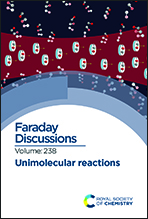Probing the dynamics of the photo-induced decarboxylation of neutral and ionic pyruvic acid†
Abstract
The dynamics of the electronically excited pyruvic acid (PA) and of its unimolecular decomposition upon single photon ionisation are investigated by means of a table top fs laser and VUV synchrotron radiation. The latter is coupled with photo-ion/photo-electron coincidence acquisition devices that allow the identification of the ionic products coming from state-to-state fragmentation upon ionisation. The fs-based setup provides time-resolved mass spectra with 266 nm (= 4.661 eV) excitation and an 800 nm multiphoton probe. For interpretation, we carried out theoretical computations using a composite scheme combining density functional theory full molecular geometric optimisation and post–Hartree–Fock correction inclusion. We therefore determined the neutral and ionic species formed during these experiments and the corresponding dissociation channels. Although several PA isomers are found, we show that solely the most stable isomer of PA (i.e. Tc) is present in the molecular beam prior to ionisation. We determined its adiabatic ionisation energy (AIE = 10.031 ± 0.005 eV). The fragmentation of the Tc+ ion occurs at ∼0.4 eV above the threshold and it is dominated by the CC bond breaking channel, forming the HOCO fragment in conjunction with the CH3CO+ ion. The decarboxylation of Tc+ channels has a minor contribution, although they are more favourable thermodynamically. These findings are in contrast with the dominance of decarboxylation while fragmenting Tc populated in the S1–S3 states. For explanation, we invoke an indirect process populating first a short lived autoionising neutral state located in energy at the HOCO + CH3CO+ dissociation limit. Later on, fragmentation occurs, followed by autoionisation. On the other hand, the fs-based experiment does not reveal any appreciable dynamics for the Tc isomer of PA after a 266 nm excitation because of non-favourable Franck–Condon factors at this energy. In sum, our work highlights the importance of the couplings between the parent ion vibrational modes and the dissociative channels in the vicinity of the loss ionic fragmentation thresholds.

- This article is part of the themed collection: Unimolecular reactions


 Please wait while we load your content...
Please wait while we load your content...